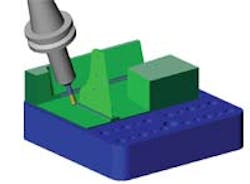Software Proves to be a Valuable Fixture
M&M Manufacturing in Tulsa is a CNC machine shop producing parts, assemblies and tooling for the energy, healthcare, and manufacturing sectors. But, the shop’s specialty is in complex-geometry aerospace components. It uses four- and five-axis machines to manufacture parts that often have three controlling datum surfaces, as well as many contoured surfaces blending into each other.
These parts are programming challenges that M&M addressed with a switch to DP Technology’s ESPRIT CAM. The software makes it possible to apply toolpaths directly to a customer’s solid geometry and view simulations of the resulting program, with the machine, tools, fixturing, etc., included, to avoid crashes.
Creative Workholding, Machining
“A key difference that we bring to our customers comes through our creativity in developing a strategy for holding and machining the part,” said Ken Statton, president of M&M Manufacturing. Statton said the shop developed expertise in fixturing as it worked to meet tight tolerance requirements, but these efforts have advanced to using fixturing to reduce machining cycle time. He pointed to a four-station fixture that M&M developed for a four-axis machine that makes it possible to perform a tool change then proceed sequentially through all the operations with that tool on all four parts. “This fixture allows us to machine four parts with only a single sequence devoted to changing, advancing, and retracting the tool,” he said. “The result is substantial time savings.”
M&M began to move to four- and five-axis machining because of the increasing complexity of the aerospace parts it is producing, and this meant it needed a software package that could import complex geometries. It chose ESPRIT because of its programming simplicity and optimizing ability. “ESPRIT gives us the optimum level of control to make sure the cutter stays in the cut as long as possible and that the program works the first time we run it,” according to Statton.
Automatic Feature Recognition
In the past, for example, if the company was making a composite layup tool with many changing contoured surfaces, it had to define each surface independently and generate toolpaths. The cutter had to move around to reach each of the different toolpaths, typically taking several days to generate the program. With ESPRIT, programmers simply import the solid model and access the full functionality for the solid model. Then, the CAM software is used to integrate the solid model to automatically identify the part features.
The next step is to assign metalcutting operations to the features that have been defined. ESPRIT lets users create a knowledge base of pre-optimized machining operations that include a particular tool, cutting speed, feedrate, depth of cut, etc. Programmers choose from several different machining strategies that automatically develop an efficiency approach for machining the feature.
